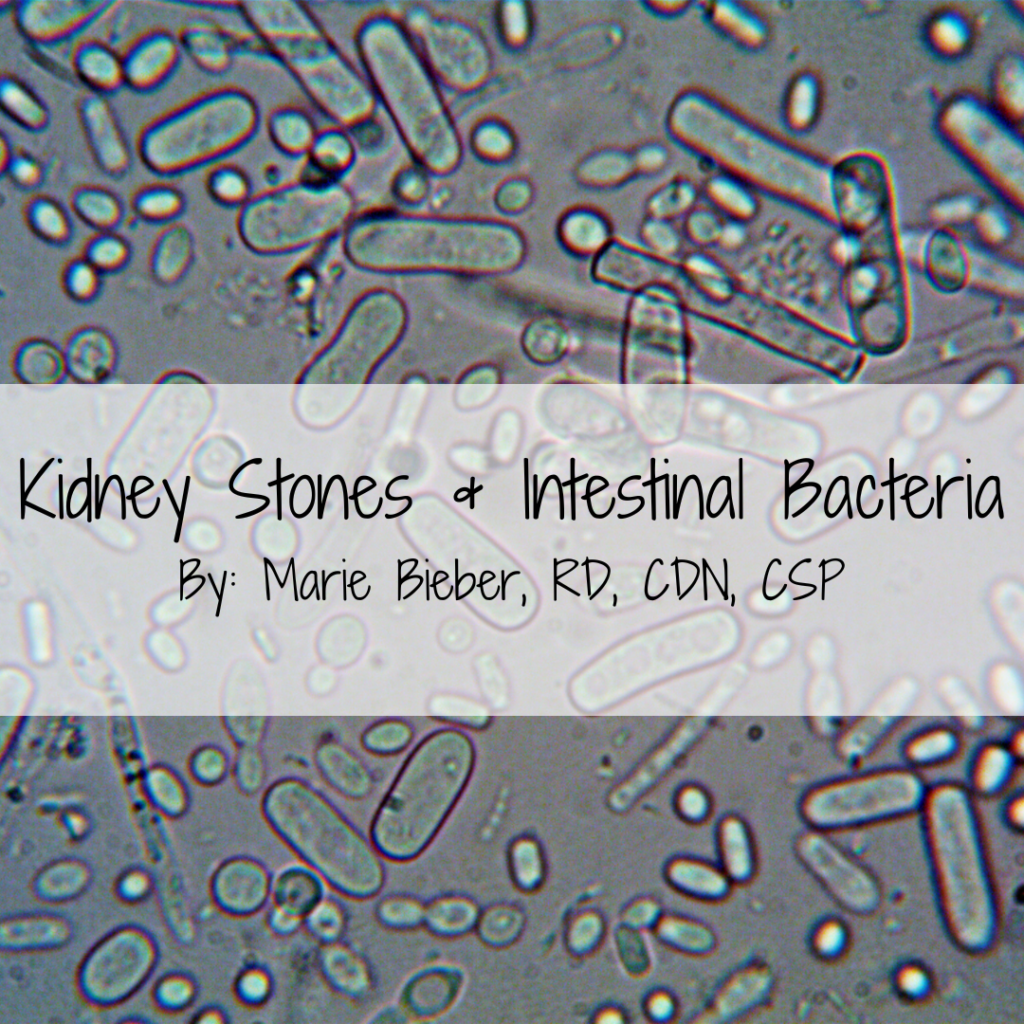
Okay, so ya’ll know I’m obsessed with gut bugs and I’m sure you’re thinking… kidney stones and intestinal bacteria, really Pearl? How you gonna connect this one? And to that I say- WATCH ME. I hope you’re ready to get your nerd on today.
We have trillions of microbes we carry around each day that are impacting our lives in so many ways- and we’re learning more and more about their impact on our overall health and well being every day. It turns out, even kidney stones are not exempt from the reach of our microbial friends.
Let’s start with the background on kidney stones so we can set the scene, then I will jump into where our microscopic mates can help or hurt our kidneys.
Kidney stones form as a result of supersaturation of minerals in the urine. This means when there are too many minerals in the urine and not enough fluid to keep those minerals mixed up in the solution, minerals can fall out of the solution and eventually lead to stone formation. This is like a cup of hot cocoa, you know how the last sip is always super chocolaty? That is because the chocolate saturated the liquid and some of it fell out of solution. The main cause of stone formation is inadequate fluid in the urine. Other causes include excess minerals in the urine, altered pH, and infection. When one or more of these factors combine, stones have the ability to form and precipitate out of solution. Stones may be calcium oxalate, calcium phosphate, uric acid, struvite, or cystine stones. Struvite stones occur as a result of an infection and cystine stones can occur due to genetics. Calcium oxalate, calcium phosphate, and uric acid stones occur as a result of these compounds falling out of solution. Today we focus on calcium oxalate stones.
Calcium Oxalate
Oxalate is a compound which is formed in the liver as a byproduct of protein breakdown. At this time, there is no known function for oxalate in the body. That isn’t to say there isn’t one, rather we just aren’t aware of one just yet. Since there is no apparent use for it in the body, it needs to be removed which is done via the urine and stool. Oxalate is found in many food items but is particularly high in spinach, rhubarb, wheat, nuts, corn, sweet potatoes, raspberries, okra, tea, coffee, and chocolate. This compound has been targeted as an anti-nutrient due to its binding capabilities. This means oxalates bind to other minerals such as calcium and iron and you are then unable to absorb the complexes meaning you don’t get the benefits of having consumed these nutrients. Remember, it’s not what you eat that matters, it’s what you absorb. In order to excrete oxalate in your urine, you must have absorbed it first OR it must be created during protein metabolism in the body. Urinary oxalate excretion increases risk of kidney stone development It is estimated about 70-80% of kidney stones are calcium oxalate stones. Anywhere from 10-50% of urinary oxalate comes from the diet (5). The amounts can vary depending on how much oxalate and calcium you consume. Based on the current literature, we no longer recommend restriction of high oxalate foods as a way to manage calcium oxalate stones. Many high oxalate foods are also highly nutritious so it doesn’t make sense to limit these minor reduction in urinary oxalates.
Intestinal Bacteria Involvement
Okay, here’s where stuff gets interesting. Turns out, there are certain types of microbes that use oxalate as an energy source. There are two types, those that use oxalate as a food source under any conditions, and those that use oxalate as a food source when they don’t have other options. When intestinal bacteria consume oxalate, the oxalate is then less available for you to then absorb. Oxalobacter formigenes is one of the bacteria that consume oxalate as an energy source. Eubacterium lentum and Enterococcus faecaelis have also been found to be oxalate-degrading microbes though these seem to consume oxalates to a lesser extent (3). Colonization of O. formigenes has been associated with a 70% reduction in overall risk of developing calcium oxalate kidney stones (6). It has been suggested that postprandial urinary oxalate excretion is a more accurate measurement of oxalate excretion (1) and O. formigenes colonization has been shown to decrease total 24-hour urinary oxalate excretion (2). O. formigenes is sensitive to the antibiotics clarithromycin and doxycycline so taking antibiotics frequently may decrease colonization. In fact, almost 100% of children have been shown to be colonized with O. formigenes and this decreases to approximately 40-60% in adults (7). GI conditions like ulcerative colitis, cystic fibrosis, and celiac disease as well as persistent diarrhea may also contribute to the loss of O. formigenes.
Diet & Supplements
To my knowledge, there are currently no commercial O. formigenes probiotics available. This particular bacteria is anaerobic, meaning it requries an environment free of oxygen, and has a high need for nutrients for growth making it a challenge to put in pill form (3). There are current efforts to develop an aerotolerant strain that may be used as a probiotic in the future.
Interestingly, a high intake of oxalate in food has been shown to increase the amount of O. formigenes though this can also increase the amount of available oxalate for stone formation. That said, a high intake of oxalate also decreases urinary calcium excretion as a result of the calcium and oxalate binding in the intestines and not being absorbed. A high intake of calcium has been demonstrated to decrease levels of O. formigenes, the thought being that increased calcium increases the binding of calcium oxalate in the intestines and therefore decreases the food source for O. formigenes. That said, diet low in calcium can also increase calcium oxalate stone formation due to more calcium entering the system from the breakdown of bone (4).
Ultimately, the best thing you can do to prevent calcium oxalate stones is drink adequate water. For more tips on how to do that check out this article. You can also work to increase your intake of high fluid foods including: fruits, vegetables, soup, stews, keifer, and milk. As long as you are consuming adequate fluid and a balanced diet rich in fruits and vegetables most people will not need to stress about altering their dietary oxalate or calcium intake. Again, fluid intake is the most important thing you can do to prevent kidney stones.
Fingers crossed one day our invisible friend O. formigenes will be available in supplemental form!
Sources
- https://www.auajournals.org/doi/abs/10.1016/S0022-5347%2817%2949808-9
- https://www.sciencedirect.com/science/article/abs/pii/S030228380300318X
- https://www.ncbi.nlm.nih.gov/pmc/articles/PMC124017/
- https://www.ncbi.nlm.nih.gov/pmc/articles/PMC3143112/
- https://www.ncbi.nlm.nih.gov/pmc/articles/PMC7823532/
- https://pubmed.ncbi.nlm.nih.gov/18322162/
- https://www.ncbi.nlm.nih.gov/pmc/articles/PMC8773937/


